People who argue that it wasn’t GM – well, Pontiac – that created the first muscle car (the 1964 GTO) arguably have history on their side. Because there were muscular cars well before 1964 – including Rocket 88 Oldsmobiles and the letter series Chryslers of the mid-late 1950s. And one thing’s for sure: Chrysler more than any other manufacturer invented – and then perfected – the gentleman’s muscle car.
It began with the C, D and E series cars – which combined NASCAR worthy V-8s and an evr-increasing emphasis on style and luxury, as the letters and years rolled on. But the concept manifested in full flower in 1967, when Chrysler – through its Plymouth division – introduced the GTX.
Unlike the GTO – which was a bare-bones brawler (at least at first) with few amenities but plenty of horsepower – the GTX was both fast and fancy. Based on the Belvedere, the GTX was upgraded with its own unique (and flashier) front and rear panels, additional chrome, dual hood scoops and available racing stripes.
Under the hood lurked either the standard “super commando” 375 hp 440 big block or – for $546 added to the MSRP – the 425 hp 426 Hemi V-8. Either way, the GTX was fast. It was simply a question of whether to go faster.
How fast?
440-powered cars were capable of getting to 60 in 6.6 seconds; the Hemi cut that down to 4.8 seconds. These cars were capable of outrageous – scary – top speeds, too. One-thirty-plus on 14-inch wheels and torsion bars. It took balls of steel to rotate the speedo’s needle all the way around the clock – but the engine was up to the job, if you were. 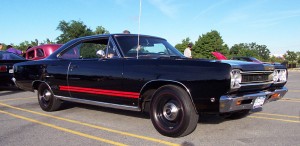
And if the Hemi wasn’t enough for you, Plymouth offered an R023 “super stock” option. It deleted much of what made a GTX a gentleman’s muscle car – including most of the insulation, the radio – even the hubcaps and heater core. But this elimination of surplusage cut down the car’s weight sufficiently to get it into the 12s – at which point, manners no longer mattered. According to Mopar historians, only about 55 of these “super stock” R023 GTXs were ever made – making them exceedingly rare (and expensive) cars today.
All GTXs received a performance-minded suspension consisting of six leaf rear springs, heavy-duty shocks and ball joints.
Front disc brakes were, however, optional.
In ’68, Plymouth added a value-priced (and less well-equipped) version of the Belvedere coupe to the lineup. This was the famous Road Runner – and it was basically a de-contened GTX. The two cars shared the same body – but the RR came standard with the lower-prestige, lower-performance 383 V-8 while the GTX continued to come standard with the mighty 440. The GTX also came standard with a three-speed Torqueflite automatic transmission – unusual for a muscle car, but then, the GTX was a gentleman’s muscle car. The rougher RR came standard with a four-speed manual.
In the GTX, the manual four-speed was a no-cost option, while you had to pay an extra $206 to get the Torqueflite in the RR.
The GTX’s office was also appointed executive-style, with woodgrain appliques and more chrome accents. The differences in content were reflected in the two cars’ differing MSRPs. A new ’68 Road Runner listed for $3,034 – while the more genteel GTX carried a sticker price of $3,355.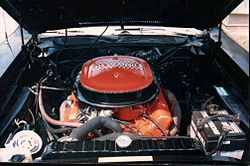
In 1969, the under-hood ante was upped considerably with the arrival of the “440+6” option ($119 extra) which replaced the super commando 440’s single four barrel intake and carburetor with a wild-looking triple two-barrel set-up. The better-fed 440 now produced 390 hp – and could run with the more costly (and higher-strung) “street” Hemi – which in fact wasn’t very streetable. The Hemi was made for racing – and performed superlatively in the extreme conditions found on NASCAR’s high-speed ovals and could take the brutal life of quarter-mile bracket racer. But for street performance, the 440 was what you wanted.
Better still, a 440+6.
1969 was also the first year for the functional Air Grabber hood – controlled by an under-dash knob. Unfortunately, ’69 was also the last year for a convertible GTX. Henceforth it – and the RR with which it shared a body – would be sold as hardtop coupes only.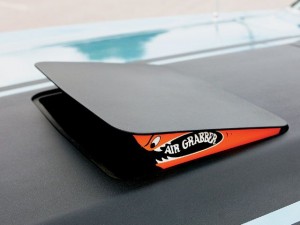
For 1970, Plymouth did something neat – something menacing – with the air grabber scoop. Instead of the previous fixed/hood-mounted deal that had an internal flapper mechanism for admitting cold air to the engine, now the entire scoop (with hungry shark decals on either side) rose up on command from the normally flat hood – giving clear notice of intent. Complementing this was a set of dummy rear brake scoops which the side racing stripes fed into like a high-speed airstream. And, for the first time, decent (from a performance point of view) 15×7 Rallye wheels with F60-15 Goodyear tires were available.
But there was a problem: The GTX was battling for customers with the increasingly similar RR – which was both lighter (due to fewer options/equipment) and thus, quicker – as well as less expensive. While GM (and Ford) also sold “twinned” (and even “tripled”) versions of one basic platform (for example, the Chevy Chevelle, Pontiac GTO and Buick GS all shared the same basic body by 1970) they didn’t compete within the same dealership. The Chevelle was sold at Chevy stores – the GTO at Pontiac stores. The Buick at Buick stores (and so on). But the GTX had to fight off the RR at the same Plymouth store. This hurt the car’s sales – badly. Only 7,748 1970 models were sold – and there was talk internally (within Chrysler) and without (in the automotive press) of the GTX’s imminent cancellation.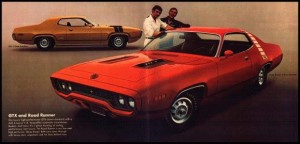 It didn’t help that by this time – early 1970s – insuring any muscle car was becoming a Sisyphean undertaking. And insuring a big block muscle car? A 440+6 muscle car? A Hemi muscle car?
It didn’t help that by this time – early 1970s – insuring any muscle car was becoming a Sisyphean undertaking. And insuring a big block muscle car? A 440+6 muscle car? A Hemi muscle car?
Forget about it!
But there would be a few more years of GTXs before the end finally came. And the end would not occur all at once.
The ’71 model featured the new “fuselage” look shared with the Dodge Charger and – again – the Road Runner. The smooth/rounded bodywork was a radical departure from the more baroque appearance of previous years. It had much in common, stylistically, with the very popular E bodies (Challenger and ‘Cuda) but was for whatever reason not as well-received. That’s putting it kindly. In fact, GTX sales wilted to just 2,942 for the entire model year – even though it had not been watered down underhood like many 1971 model year competitors. In fact, ’71 was arguably the high water mark for GTX muscularity. Both the 390 hp 440+6 and the 425 hp 426 Hemi were still available – with the 440+6 now putting out the same 490 lbs.-ft. of torque as the Hemi, but at considerably lower engine RPM (3,200 vs. 4,000 for the Hemi).
Still, a chill wind was blowing. ’71 would be the final year for the GTX as a separate model (the same thing would happen to the Pontiac GTO not long after). Now – for 1972 and thereafter until the end, in 1974 – the GTX became a mere options package you could order with the Road Runner. In other words, it had been subsumed by its budget-minded in-house rival.
The GTX package upgraded the Road Runner to 440 power under the hood – although by now the 440 was detuned and could no longer be ordered with the triple two-barrel induction system. Still, even “detuned,” the 440 delivered 280 SAE net hp – a very big number by 1974. And one easily increased, if one so desired, by retrofitting earlier year components, such as the triple carb intake and more aggressive camshafts of pre-1972. But even that door was closed next model year – 1975 – when catalytic converters were adopted industry-wide and with them, single exhaust and with that, smaller, less powerful engines. The 440 disappeared. 400s and 360s and 318s were as good as it got.
And it would get worse, soon.
The GTX ceased to exist altogether after ’74. The Road Runner limped along for just one more year before it, too, was stricken from the roster.
Shadows and dust.
But, every once in awhile, you’ll hear the distinctive roar of a 440+6 coming on the cam, off in the distance. They may not be making them anymore, but at least they did make them – once upon a time.
Perhaps, one day, they will make them again… .
Throw it in the Woods?









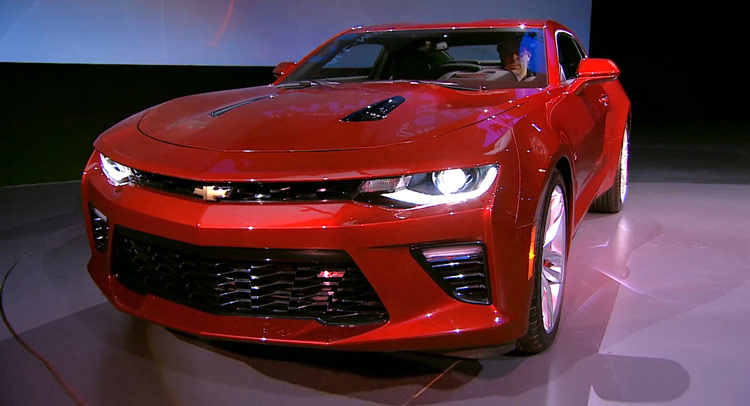
Chrysler was always on the cutting edge of engineering. From the 1934 Airflow (which sadly was a flop–people weren’t ready for that yet) to alternators, solid-state car radios, electronic ignition systems, and other advances, from an engineering standpoint, Chrysler was more advanced than the other automakers.
Let’s not forget Chrysler’s turbine cars, 50 were made, of which the bodies were produced by Ghia, with Chrysler turbine (jet) engine drivetrains and were “loaned” to ordinary consumers for various periods of time. The consumers selected took the cars home and were encourage to drive them in ordinary use. This was a marketing masterpiece, the cars drawing crowds wherever they went.
The bodies were imported under a “special license” which required them to be crushed (sob) or taken out of the country. I believe that there are still four examples in the USA. Jay Leno owns one and two of the three are probably in private hands. I think Chrysler (Stellantis) still has one.
With the advent of automotive “pollution controls”, Chrysler gave up on the turbine program. Controlling CO was not a problem, it was NOx that was problematic.
Steve Lehto wrote an excellent book on Chrysler’s turbine program.
Let’s not forget the “Silver Bullet” 1967 Plymouth GTX which ruled Detroit’s Woodward Avenue back in the day. Factory racing teams (that the automakers declared “did not exist”) would “unofficially” run their products on Woodward Avenue.
Gratiot Ave. was the east side’s “dragstrip”.
Telegraph Road was the west side’s “dragstrip”.
On a personal note, I would write letters (sometimes weekly) to Chrysler’s engineers posing questions about technical aspects of their drive trains. I always received polite letters back along with engineering data which I have to this very day. Some of this documentation belongs in a museum.
Our local “unsanctioned” dragstrip (Dunn Road) was located on the east side of Detroit between Jos. Campau Ave. and Mt. Elliot Ave. (near the Detroit/Hamtramck border). This was a good mile of straightaway with no residences or factory entrances with parking lots on both sides with only one small problem. At the end of the mile, there were railroad tracks and a 45-degree “turn to the left”. Those who did not slow down would fly off the railroad tracks and hit an industrial building (brick) located at that 45-degree turn.
A friend of mine purchased an 67 Olds 4-4-2 and let his brother “take it out for a spin”. He ended up hitting the wall. He had to walk back to the house and tell his brother that he totaled his car (that he only had for thee days).
That’s my story…enjoy.
Don’t know how old your friend’s Challenger was at the time you experienced it, but it might of had and issue with a tired or out of adjustment torsion bars.
While Chrysler compensated for the driver side weight bias by angling the motor a few degrees to the right side to minimize the weight difference, there was still a weight bias to the left which required a preload of the left torsion bar to compensate. That left side torsion bar would tire(lose its tension) earlier then the right side. The result was side to side rolling action of a few degrees along the longitudinal axis. especially if the shocks were also tired. New torsion bars or a readjustment, and gas shocks went a long way to curing that.
It could have also been poorly adjusted replacement torsion bars or even a front end hit damage repaired, but with out readjusting the bars. Even with out damage or replacement, torsion bars could use an adjustment when regular alignments were done. It was quite easy, even without the special tool available for the job. If this periodic adjustment was neglected, some body roll could develop and would be exacerbated by tired shocks.
On the ‘E’ bodied cars with their unit construction and fairly weak sub-frames, the situation could develop much earlier due to less support because of a flexing front end. Add to that, the propensity for the ‘E’ body cars to greatly under steer and you had a handling handful. I never found the ‘E’ body cars to be fun to drive unless it was the quarter mile.
My 62′ Valiant, stock, and even later with the 440″, handled better then an ‘E’ body car. With bigger radial tires, adjustable gas shocks, shortened ‘B’ body torsion bars, the little Valiant could carve curves pretty darn well, even with that big 440″. Would love to find another one and put an LS376 in it.
Back to work……….>
Recent new comments brought me to this string, which I had not happened to see before. (I used to only visit EPA when Lew Rockwell linked to it.)
Back in the day, in small town Kansas, there were 2 ’62 Chevy 409s – think they were Belairs, but not sure. One was owned by a young farmer who also owned the first turbo diesel tractor in the area, a 1206. The other owner fell for Plymouth advertising the heck out of the “new” Road Runner, and had to have one. As you noted, that 1st year it had only the vanilla 383. Boy was he disappointed. Went to my classmate who had bought his 409 and tried to get it back. No dice.
Of course the car in town that nothing else (around there, anyway) would touch was a ’67 Nova with 350hp 327.
Hi Phillip,
The 383 was an ok street car in stock trim – but that 440 … wow!
Mopars also seemed scarier because of their (in general) loosey goosey suspensions and steering, terrible brakes – and ponderous weight. My buddy’s ’71 GTX, for example, rode on 14 inch Hurst mags, had one-finger power steering and more body roll than Shamu doing tricks at Sea World!
I never said the 383 was not decent, just did not live up to his expectations from the hype. And he had been driving a 409.
Oh, agreed – I didn’t mean to sound as though I was slamming what you said!
I regard the 383 as the Mopar equivalent of the standard performance 396. Both were good, torquey street engines that worked really well with automatics in fairly heavy cars, like the RR (and Chevelle).
Hi! Eric, long time no visit(too much work and play lately), but your remarks(“Mopars also seemed scarier because of their (in general) loosey goosey suspensions and steering,”) about MOPAR handling from a guy who I thought was widely knowledgeable and unprejudiced, motivated me to comment.
MOPARs in the day were noted for their above average handling because of their torsion bar suspension and being generally equipped, with their performance models, with pretty heavy duty front & rear sway bars. Their police models were developed for handling(and they sold a lot of those) and most of that trickled down to the civilian cars and wholly transferred down to the RT’s and other performance cars from Dodge and Plymouth.
Just about everybody had bad brakes unless they had a disc brake option. Only GM in the late sixties had decent power steering.
For my high speed runs in my Charger, I removed the power steering belt, sure it gave a little more high speed power, but the main reason was to calm the steering down at very high speed. The chassis was pretty solid above 135mph, way better them some of the other cars that we ran top speed runs with. Some scared the hell out of us and we backed out even though there was plenty of power left. Ford products seemed to be the worst with their soft Lincoln rides and over boosted steering even in their 7-Litre model that supposedly had performance suspension upgrades.
Olds 442’s and the Buick GS also performed fairly well at speed, though, they were greatly drag limited by 68′ and and later.
Around corners, the MOPARs and 442’s and GS’s were pretty good, though, they all under steered and then went into snap over steer if you over corrected because you took to much speed into the corner for the capability of the chassis.
Gas shocks and radial tires made huge improvements on those old cars, but we all bought a lot of different size sway bars trying to find good handling. I modified bars with adjustable linkage to try and fine tune handling.
All of that early suspension work and track time has served me well over the years, now I’m sort of a suspension/handling guru and making money at it and car builds, and LS transplants.
Just kidding, still think your one of ‘the’ cars guys. And all of the above is just my three cents worth drawn from a lot of experience.
Regards… Tre
Note; For quite a few years(66-71), their was, every few weeks, an illegal high speed highway run near area where I lived. It was in a very rural area and it was organized, and we did impose some rules and safety regimes/inspections loosely based on SCTA rules. Nobody raced side by side. They were timed at the 2-1/2 mile mark. Vettes dominated the times. Nobody was ever injured or killed, but I can’t say that all the cars survived intact. I ran the Charger and Vettes. Some of us eventually took up road racing on race tracks, but that was with sports cars and GT’s, not big or mid-size American sedans.
Hi! Eric… My thought is, that maybe by the time you drove or had any experience in MOPAR’s, they might have been quite old and tired. For the filming of the great car movie ‘Bullit’. Only one Charger was needed for the stunt driving as they held up quite well during the abusive stunts, compared to the Mustang. And this from some research about the cars in the movie.
“both Charger and Mustang GT were tested at a track for performance. To every one’s chagrin, the Charger RT out ran and cornered better than the Mustang GT. They used skinny tires to handicap the Charger RT for filming but it still outgunned the Mustang easily.”
I have read similar accounts, before.
For me, after the Corvette, gen_11 Corvair, and 64′-67′ 442’s, American cars really didn’t come of age in the handling department until the Gen-2 ‘F’ bodies. Even a base model Camaro or Bird had pretty dynamic handling compared to any thing else offered by the Big Three. And as far as I’m concerned, they never gave that up until the last generation. The Gen_111 dramatically built on the Gen_11’s handling.
I’m a big fan of Mustangs, but they just never had the finesse in a corner that the ‘F’ bodies had, with the exception of the SVO and 2000 Cobra ‘R’ both of which outclassed anything before or since, even the LE1’s. The new Camaro’s handle great, but are handicapped by their weight. Hoping the new 2015-16(?) rectifies that situation. If not a new 2015 Mustang with a Turbo four, will probably find a home in my shop.
Hi Tre,
I should have qualified my comments – which were based on the second gen. F cars as exemplars of handling for that era. The early ’70s Firebirds were ballerinas compared with the oafish (in comparison) Mopars my friends owned. GM did really excellent work with the second generation Camaro/Firebird. Even by modern standards, they handle well (the ride is another thing, of course).
I had a friend who owned a ’72 Challenger. It was not bad. The main deficit, as I recall, was excessive body lean, but the steering was decent and the car could be throttle steered through a corner pretty adroitly if the driver knew how to drive!
It should be noted, that I owned an SVO, 1LE, and Cobra ‘R’. The SVO was a personal car, and the 1LE and Cobra ‘R’ were dedicated track cars. So I speak with a modicum of experience regarding those cars.
I spent seven great days in a Cobra R back in ’95…. and could have bought the car, but like an idiot, didn’t!
I cut fairways all summer in ’82 to ditch my ’67 Triumph Spitfire to grab a ’70 GTX, 440+6. Back then there were not replacement parts or rebuilders for the six-pack. 2 of the three butterfly rod holders were warped, and had vacuum leaks everywhere. I sold the 6 pack for the price I paid for the car. Now Edelbrock makes the intake & carbs. I but a Holley 850 on it and it would get rubber @ 55 mph by just stomping on it. And that was w/our small towns 1st set of Mickey Thompson Street Slicks. They hooked so well that the left front would come off the ground….which eventually ruined all the fender mounting holes by egg shaping them! Learned how to weld fixing those holes & re drilling them.
Traded that for a ’66 Buick Gran Sport (Henceforth shortened to GS) w/dual quad 401. It was a Christmas present to the dealers daughter @ Christmas. She drove it for a year, then the service manager bought it & kept it until I came along. My 1st frame off resto. Red/black/black. The body line on the Buick REALLY grew on me and set it apart from any ’66 GM.
Those are some great cars – I’m jealous!
I did get some seat time in my buddy’s ’71 440 4-BBL GTX. I had another friend who had a ’72 455 HO Formula. And I still have a friend who owns a one of 15 built ’70 RA III 400 Formulas with the three speed manual, 14 inch rims and nothing else.
TA’s> http://redding.craigslist.org/cto/3719868761.html
Road Runner> http://redding.craigslist.org/cto/3719868761.html
GTO? Olds ’88’? Any automotive enthusiast/historian worthy of his driving gloves and petrol fueled circulatory system, knows it was the 57′ Rambler American ‘Rebel’ that carries that water. The first true definition of a ‘Muscle’ car is embodied in that model.
When I was a kid, hot street performance, with my Dad and uncles and among their gearhead friends, was all about Packard Hawks and Rebels
The first serious burn out on the street by a stock production car I recall seeing, was by a Rebel owned by my uncle. The damn thing ran away from my Dad’s 300SL that cost four times as much money. Dad had a lot of respect for that car and later my Grandfather bought one in 1960 and again in 66′, though, by then, they had been eclipsed by the new Muscle cars.
While it is arguable that the early Old’s ’88’ was a precursor to the ‘Muscle’ car, its near 120″ wheelbase defined it as full size and not mid sized. Too put things in perspective, the Rebel had a shorter wheelbase then the present day Mustang/Camaro, and for that matter, a Scion Tc coupe.
I’m not gonna step into this bear trap, Deuce!
The debate over which car was the first muscle car will echo through eternity. I’m perfectly content to like ’em all!
COL! And there it is…..
My high school buddy had a ’71… 440 4 barrel/automatic. It was a metallic brown color with red “GTX” badges and – probably very rare – Hurst mags. The roll-on acceleration of that beast is something I will never forget.
most everyone missed the first big three (meaning chev,ford mopar) factory muscle-cars, 1956 plymouth fury or 1956 dodge D500 both performance models,i had fury and got low 14’s quarter mile with only mods being exxon “bucron” sticky rear tires!it also got me a ticket of 132mphs,tons of fun!
Personally I always liked the bare bones performance cars more than the more luxurious models.
Something about the hairshirt sacrifices for the sake of pure performance just appealed to me for whatever reason.
RR over GTX any day.
I’d be very happy with either!
True story: Back in the ’80s, my high school friend bought a ’71 GTX 440 – in what we’d consider today very solid #3, almost #2 condition – for $2,200.
Imagine that. Being a high school kid – and able to afford a big block muscle car.
The original basic 1968 Road Runner came with a “taxicab interior”, vinyl seats with rubber floor covering (no carpeting). Such a light car (approximately 2300 lbs) was wickedly fast, even with the 383 and 4-speed. Subsequent years saw carpeting and upgraded interiors.
Neat; I had never heard of or seen an ‘Air Grabber’ hood.
It must have been fun and hilarious, popping that thing up; kind of like unzipping your pants and whipping it out!
Dad had 2 Chargers, a ’72 and a ’76. The 72 was something to see, with hide-away headlights that never seemed to work right and massive rust on the big flat tops of the fenders. But when it ran it was pretty cool. Years later we got a “cheap Plymouth” Horizon. Dad always said it that way (knowing full well they came off the same assembly line), as an expression of his love of Dodge Brother’s engineering.
Historically, Chrysler engineering (as in, engines, etc.) was usually very good. But overall quality control was a bit behind the others. The analog is Kawasaki, back in the day. Honda made the highest-quality stuff; excellent fit and finish, precision-built. But if you wanted wild – you wanted a Kaw. Just as circa 1970, the wildest things on four wheels were coming out of Chrysler….
“Baroque” is a good word to describe the GTX’s styling. It was at the outer edge of the industry wide design trend of the time……crisp and squared up. The antithesis of the streamlined, jet plane body styles of the late 50s and early 60s. But it worked…looked cool in its own way.
Fake woodgrain interiors were always a horrid feature. I hated them then and now. Wouldn’t stop me from grabbing a GTX. But my interior restoration would not be “historically accurate.” 😉
I’m like you…Mopar muscle cars are my favorites. If I could have my favorite Mopar, gimme a Dodge Charger…straight out of Duke of Hazard!
As you know, the true “Golden Age” of muscle cars is Right Now. It would be fun to read analyses of the current fastest Camaro, Mustang, and Challenger models in your Retro Review format.
Dodge made that one? You learn something new every day. It is similar to a Pontiac GTO. I bash Dodge all the time but I have to admit the jeep, certain Ram trucks and the Mopar era are good vehicles.
Plymouth!
These were big, mean cars. I had a good friend back in the day who owned one – a ’71 440 with the Air Grabber hood. It had Hurst 14-inch mags, the wing on the trunk and those massive gattling gun exhaust tips under the back bumper. We raced a brand-new ’87 Corvette – and beat him.
But, nearly crapped our pants doing it!